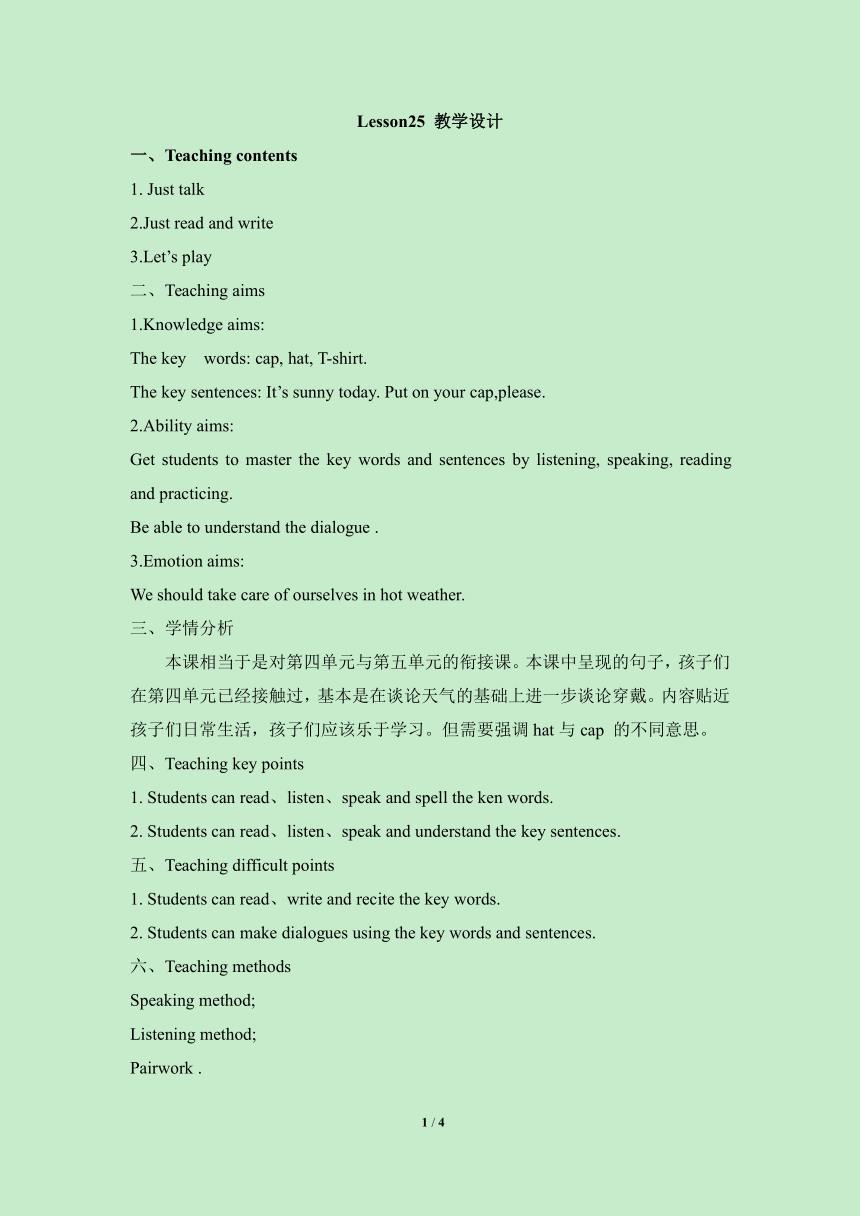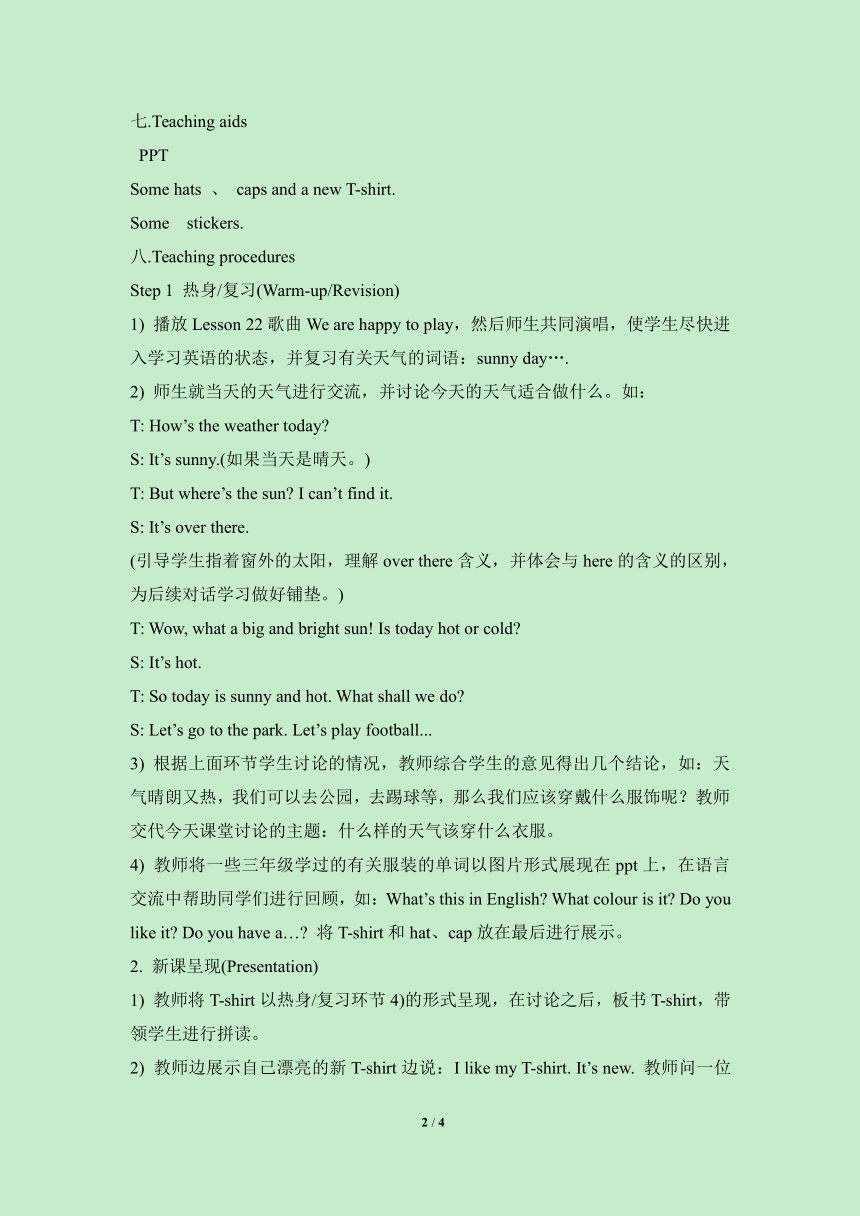Unit5 I like those shoes Lesson25 教案
文档属性
| 名称 | Unit5 I like those shoes Lesson25 教案 |  | |
| 格式 | doc | ||
| 文件大小 | 41.0KB | ||
| 资源类型 | 教案 | ||
| 版本资源 | 人教精通版(三年级起点) | ||
| 科目 | 英语 | ||
| 更新时间 | 2020-09-12 15:52:13 | ||
图片预览


文档简介
Lesson25 教学设计
一、Teaching contents
1. Just talk
2.Just read and write
3.Let’s play
二、Teaching aims
1.Knowledge aims:
The key words: cap, hat, T-shirt.
The key sentences: It’s sunny today. Put on your cap,please.
2.Ability aims:
Get students to master the key words and sentences by listening, speaking, reading and practicing.
Be able to understand the dialogue .
3.Emotion aims:
We should take care of ourselves in hot weather.
三、学情分析
本课相当于是对第四单元与第五单元的衔接课。本课中呈现的句子,孩子们在第四单元已经接触过,基本是在谈论天气的基础上进一步谈论穿戴。内容贴近孩子们日常生活,孩子们应该乐于学习。但需要强调hat与cap 的不同意思。
四、Teaching key points
1. Students can read、listen、speak and spell the ken words.
2. Students can read、listen、speak and understand the key sentences.
五、Teaching difficult points
1. Students can read、write and recite the key words.
2. Students can make dialogues using the key words and sentences.
六、Teaching methods
Speaking method;
Listening method;
Pairwork .
七.Teaching aids
PPT
Some hats 、 caps and a new T-shirt.
Some stickers.
八.Teaching procedures
Step 1 热身/复习(Warm-up/Revision)
1) 播放Lesson 22歌曲We are happy to play,然后师生共同演唱,使学生尽快进入学习英语的状态,并复习有关天气的词语:sunny day….
2) 师生就当天的天气进行交流,并讨论今天的天气适合做什么。如:
T: How’s the weather today?
S: It’s sunny.(如果当天是晴天。)
T: But where’s the sun? I can’t find it.
S: It’s over there.
(引导学生指着窗外的太阳,理解over there含义,并体会与here的含义的区别,为后续对话学习做好铺垫。)
T: Wow, what a big and bright sun! Is today hot or cold?
S: It’s hot.
T: So today is sunny and hot. What shall we do?
S: Let’s go to the park. Let’s play football...
3) 根据上面环节学生讨论的情况,教师综合学生的意见得出几个结论,如:天气晴朗又热,我们可以去公园,去踢球等,那么我们应该穿戴什么服饰呢?教师交代今天课堂讨论的主题:什么样的天气该穿什么衣服。
4) 教师将一些三年级学过的有关服装的单词以图片形式展现在ppt上,在语言交流中帮助同学们进行回顾,如:What’s this in English? What colour is it? Do you like it? Do you have a…? 将T-shirt和hat、cap放在最后进行展示。
2. 新课呈现(Presentation)
1) 教师将T-shirt以热身/复习环节4)的形式呈现,在讨论之后,板书T-shirt,带领学生进行拼读。
2) 教师边展示自己漂亮的新T-shirt边说:I like my T-shirt. It’s new. 教师问一位同学:Do you have a new T-shirt? 学生回答。教师追问:But where’s your new T-shirt? 教师指着课前收集放在讲台附近的衣物说:Oh, it’s here.引导学生说出:It’s over there. 在复习环节因为有了over there的铺垫,学生能够比较顺利地在此情境中理解此句,并区分与here含义的不同。
3) 教师同时展示cap和hat,在对比中帮助学生理解两词的含义。板书cap和hat,带领学生拼读,同时与cat比较读音,便于学生记忆单词。
4) 教师边展示自己的new cap和new hat边说:It’s sunny today. I’ll put on my cap/hat. 教师戴上自己的帽子,然后问学生:Do you have a new cap/hat? Where’s your new cap/hat? 学生指着被教师收集在一起的讲台上的帽子回答:It’s over there.教师将帽子递给学生,并建议说:Oh, your cap/hat is so nice. Put on your cap/hat, please.学生接过帽子并戴上,同时说:Thank you. 此环节在师生真实的交流中呈现句子:It’s sunny today. Put on your ...
5) 观看本课对话课件,整体感知本课对话内容,并朗读课文。
3. 趣味操练(Practice)
Play a chain game:教师对同学发出指令:It’s sunny. Put on a cap.或It’s cold. Put on your hat. 此同学需从收集上来的cap和hat中找出自己的cap或hat戴上,如果找对了就继续向其他同学发出指令,如果找错了就出局(out)。
4. 语言运用(Language use)
场景设置:完成热身与复习环节中的任务。讨论什么样的天气适合穿什么衣服。依据以下表格进行讨论并将结果填在表格空格中。建议教师先和一位同学进行讨论,提供范例。
Weather Clothes
sunny hat
cold coat
cool shirt
warm sweater
语言支持:
A: How’s the weather?
B: It’s sunny.
A: Put on your cap,please.
B: Thank you.
九.homework.
1.听录音,跟读Just talk部分的课文录音,注意语音、语调。
2.按要求抄写57页的单词和句子。
3.观看天气预报,并运用本课所学句型给自己的父母提一些穿衣的建议。
4.预习Lesson26。
十.Blackboard design.
Unit 5 Lesson 25
It’s sunny today. Put on your cap, please. cap
hat
T-shirt
4 / 4
一、Teaching contents
1. Just talk
2.Just read and write
3.Let’s play
二、Teaching aims
1.Knowledge aims:
The key words: cap, hat, T-shirt.
The key sentences: It’s sunny today. Put on your cap,please.
2.Ability aims:
Get students to master the key words and sentences by listening, speaking, reading and practicing.
Be able to understand the dialogue .
3.Emotion aims:
We should take care of ourselves in hot weather.
三、学情分析
本课相当于是对第四单元与第五单元的衔接课。本课中呈现的句子,孩子们在第四单元已经接触过,基本是在谈论天气的基础上进一步谈论穿戴。内容贴近孩子们日常生活,孩子们应该乐于学习。但需要强调hat与cap 的不同意思。
四、Teaching key points
1. Students can read、listen、speak and spell the ken words.
2. Students can read、listen、speak and understand the key sentences.
五、Teaching difficult points
1. Students can read、write and recite the key words.
2. Students can make dialogues using the key words and sentences.
六、Teaching methods
Speaking method;
Listening method;
Pairwork .
七.Teaching aids
PPT
Some hats 、 caps and a new T-shirt.
Some stickers.
八.Teaching procedures
Step 1 热身/复习(Warm-up/Revision)
1) 播放Lesson 22歌曲We are happy to play,然后师生共同演唱,使学生尽快进入学习英语的状态,并复习有关天气的词语:sunny day….
2) 师生就当天的天气进行交流,并讨论今天的天气适合做什么。如:
T: How’s the weather today?
S: It’s sunny.(如果当天是晴天。)
T: But where’s the sun? I can’t find it.
S: It’s over there.
(引导学生指着窗外的太阳,理解over there含义,并体会与here的含义的区别,为后续对话学习做好铺垫。)
T: Wow, what a big and bright sun! Is today hot or cold?
S: It’s hot.
T: So today is sunny and hot. What shall we do?
S: Let’s go to the park. Let’s play football...
3) 根据上面环节学生讨论的情况,教师综合学生的意见得出几个结论,如:天气晴朗又热,我们可以去公园,去踢球等,那么我们应该穿戴什么服饰呢?教师交代今天课堂讨论的主题:什么样的天气该穿什么衣服。
4) 教师将一些三年级学过的有关服装的单词以图片形式展现在ppt上,在语言交流中帮助同学们进行回顾,如:What’s this in English? What colour is it? Do you like it? Do you have a…? 将T-shirt和hat、cap放在最后进行展示。
2. 新课呈现(Presentation)
1) 教师将T-shirt以热身/复习环节4)的形式呈现,在讨论之后,板书T-shirt,带领学生进行拼读。
2) 教师边展示自己漂亮的新T-shirt边说:I like my T-shirt. It’s new. 教师问一位同学:Do you have a new T-shirt? 学生回答。教师追问:But where’s your new T-shirt? 教师指着课前收集放在讲台附近的衣物说:Oh, it’s here.引导学生说出:It’s over there. 在复习环节因为有了over there的铺垫,学生能够比较顺利地在此情境中理解此句,并区分与here含义的不同。
3) 教师同时展示cap和hat,在对比中帮助学生理解两词的含义。板书cap和hat,带领学生拼读,同时与cat比较读音,便于学生记忆单词。
4) 教师边展示自己的new cap和new hat边说:It’s sunny today. I’ll put on my cap/hat. 教师戴上自己的帽子,然后问学生:Do you have a new cap/hat? Where’s your new cap/hat? 学生指着被教师收集在一起的讲台上的帽子回答:It’s over there.教师将帽子递给学生,并建议说:Oh, your cap/hat is so nice. Put on your cap/hat, please.学生接过帽子并戴上,同时说:Thank you. 此环节在师生真实的交流中呈现句子:It’s sunny today. Put on your ...
5) 观看本课对话课件,整体感知本课对话内容,并朗读课文。
3. 趣味操练(Practice)
Play a chain game:教师对同学发出指令:It’s sunny. Put on a cap.或It’s cold. Put on your hat. 此同学需从收集上来的cap和hat中找出自己的cap或hat戴上,如果找对了就继续向其他同学发出指令,如果找错了就出局(out)。
4. 语言运用(Language use)
场景设置:完成热身与复习环节中的任务。讨论什么样的天气适合穿什么衣服。依据以下表格进行讨论并将结果填在表格空格中。建议教师先和一位同学进行讨论,提供范例。
Weather Clothes
sunny hat
cold coat
cool shirt
warm sweater
语言支持:
A: How’s the weather?
B: It’s sunny.
A: Put on your cap,please.
B: Thank you.
九.homework.
1.听录音,跟读Just talk部分的课文录音,注意语音、语调。
2.按要求抄写57页的单词和句子。
3.观看天气预报,并运用本课所学句型给自己的父母提一些穿衣的建议。
4.预习Lesson26。
十.Blackboard design.
Unit 5 Lesson 25
It’s sunny today. Put on your cap, please. cap
hat
T-shirt
4 / 4
同课章节目录
- Unit 1 This is my new friend.
- Lesson 1
- Lesson 2
- Lesson 3
- Lesson 4
- Lesson 5
- Lesson 6 Revision
- Unit 2 What's your number?
- Lesson 7
- Lesson 8
- Lesson 9
- Lesson 10
- Lesson 11
- Lesson 12 Revision
- Unit 3 It's a pineapple.
- Lesson 13
- Lesson 14
- Lesson 15
- Lesson 16
- Lesson 17
- Lesson 18 Revision
- Fun Time 1
- Recycle 1
- Recycle 2
- Project
- Unit 4 How's the weather today?
- Lesson 19
- Lesson 20
- Lesson 21
- Lesson 22
- Lesson 23
- Lesson 24 Revision
- Unit 5 I like those shoes.
- Lesson 25
- Lesson 26
- Lesson 27
- Lesson 28
- Lesson 29
- Lesson 30 Revision
- Unit 6 I'm tall.
- Lesson 31
- Lesson 32
- Lesson 33
- Lesson 34
- Lesson 35
- Lesson 36 Revision
- Fun Time 2
- Recycle 1
- Recycle 2
- Project
